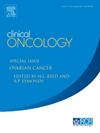Comparative Outcomes and Toxicity in Patients With Esophageal Cancer After Trimodality Therapy With Step-and-Shoot Intensity-Modulated Radiation Therapy Versus Volumetric Modulated Arc Therapy: The MD Anderson Experience
IF 3.2
3区 医学
Q2 ONCOLOGY
引用次数: 0
Abstract
Aims
To evaluate outcomes and toxicity after intensity-modulated radiation therapy given as step-and-shoot (SS) or volumetric modulated arc therapy (VMAT) for patients with locally advanced esophageal cancer treated with trimodality therapy (i.e. neoadjuvant concurrent chemoradiation therapy followed by surgery).
Materials and Methods
Patients consecutively treated with trimodality therapy including IMRT in 2001–2022 (n = 449) were retrospectively reviewed, and 106 pairs of propensity-matched SS and VMAT patients were identified. Survival, recurrence, surgery-related prognostic factors, and chemoradiation-related toxicities were evaluated between groups.
Results
Baseline characteristics were balanced between both groups except for body mass index, history of other cancer, clinical disease stage, and use of induction chemotherapy. Median follow-up time was 40 months. Relative to SS, VMAT led to higher 3-year overall survival (OS; P = 0.028, hazard ratio [HR] 0.645, 95% confidence interval [CI] 0.436–0.954) but not progression-free, locoregional recurrence-free, or distant metastasis-free survival. No predictor of excellent OS by SS versus VMAT was identified in multivariable analyses. However, VMAT was associated with reduced odds of postoperative cardiac complications (P < 0.001, odds ratio [OR] 0.296, 95% CI 0.148–0.591), pulmonary complications (P = 0.048, OR 0.539, 95% CI 0.292–0.994), pathologic partial response or worse (≥10% viable cells; P = 0.003, OR 0.418, 95% CI 0.235–0.743), and positive/close margins (P = 0.023, OR 0.346, 95% CI 0.138–0.867) relative to SS. VMAT was also associated with reduced rates of chemoradiation therapy-related weight loss (33.0% versus 79.2%, P < 0.001), fatigue (40.6% versus 68.9%, P < 0.001), nausea (31.1% versus 58.5%, P < 0.001) and cardiac toxicity (0% versus 6.6%, P = 0.007) than SS.
Conclusion
Based on this single institution, retrospective study with a 40-month median follow-up, VMAT utilization in trimodality treatment for locally advanced esophageal cancer appears to be associated with improved OS and rates of concurrent chemoradiation therapy-related toxicity and reduced initial 12-month postoperative complications relative to SS IMRT. Multi-institutional prospective trials addressing the limitations of this study and with longer follow-ups are warranted to validate these findings.
食管癌患者在三段式治疗中采用步射调强放疗与体积调弧放疗的比较结果和毒性:MD安德森经验。
目的:评价局部晚期食管癌患者在接受三模式治疗(即手术后新辅助同步放化疗)后,采用步射调强放射治疗(SS)或体积调弧放射治疗(VMAT)的结果和毒性。材料与方法:回顾性分析2001-2022年连续接受包括IMRT在内的三段式治疗的患者(n = 449),发现106对倾向匹配的SS和VMAT患者。评估两组患者的生存、复发、手术相关预后因素和放化疗相关毒性。结果:两组患者除体重指数、其他肿瘤病史、临床疾病分期和诱导化疗使用情况外,基线特征基本平衡。中位随访时间为40个月。相对于SS, VMAT导致更高的3年总生存期(OS;P = 0.028,危险比[HR] 0.645, 95%可信区间[CI] 0.436-0.954),但无进展、局部无复发或远处无转移生存期不存在差异。在多变量分析中,没有发现SS与VMAT的良好OS预测因子。然而,VMAT与术后心脏并发症(P < 0.001,比值比[OR] 0.296, 95% CI 0.148-0.591)、肺部并发症(P = 0.048, OR 0.539, 95% CI 0.292-0.994)、病理部分反应或更差(活细胞≥10%;与SS相比,VMAT还与放化疗相关的体重减轻(33.0%比79.2%,P < 0.001)、疲劳(40.6%比68.9%,P < 0.001)、恶心(31.1%比58.5%,P < 0.001)和心脏毒性(0%比6.6%,P = 0.007)发生率降低相关。基于这一单一机构,中位随访时间为40个月的回顾性研究,相对于SS IMRT, VMAT在局部晚期食管癌三段式治疗中的应用似乎与改善的OS和同步放化疗相关毒性发生率以及减少最初12个月术后并发症有关。多机构前瞻性试验解决了本研究的局限性,并进行了更长时间的随访,以验证这些发现。
本文章由计算机程序翻译,如有差异,请以英文原文为准。
求助全文
约1分钟内获得全文
求助全文
来源期刊

Clinical oncology
医学-肿瘤学
CiteScore
5.20
自引率
8.80%
发文量
332
审稿时长
40 days
期刊介绍:
Clinical Oncology is an International cancer journal covering all aspects of the clinical management of cancer patients, reflecting a multidisciplinary approach to therapy. Papers, editorials and reviews are published on all types of malignant disease embracing, pathology, diagnosis and treatment, including radiotherapy, chemotherapy, surgery, combined modality treatment and palliative care. Research and review papers covering epidemiology, radiobiology, radiation physics, tumour biology, and immunology are also published, together with letters to the editor, case reports and book reviews.
 求助内容:
求助内容: 应助结果提醒方式:
应助结果提醒方式:


